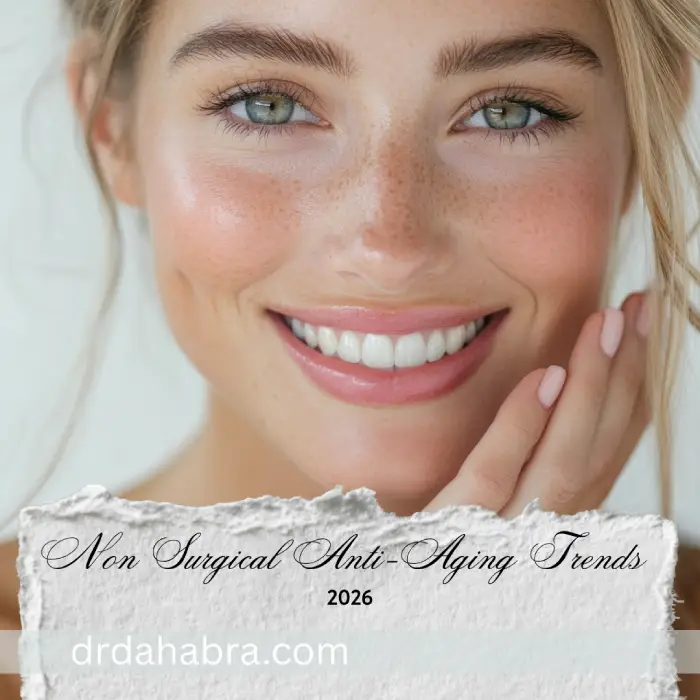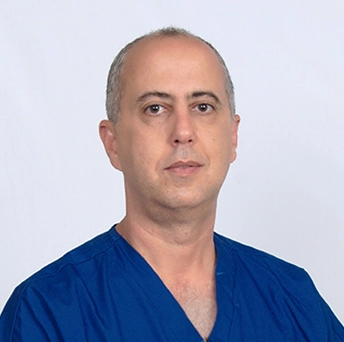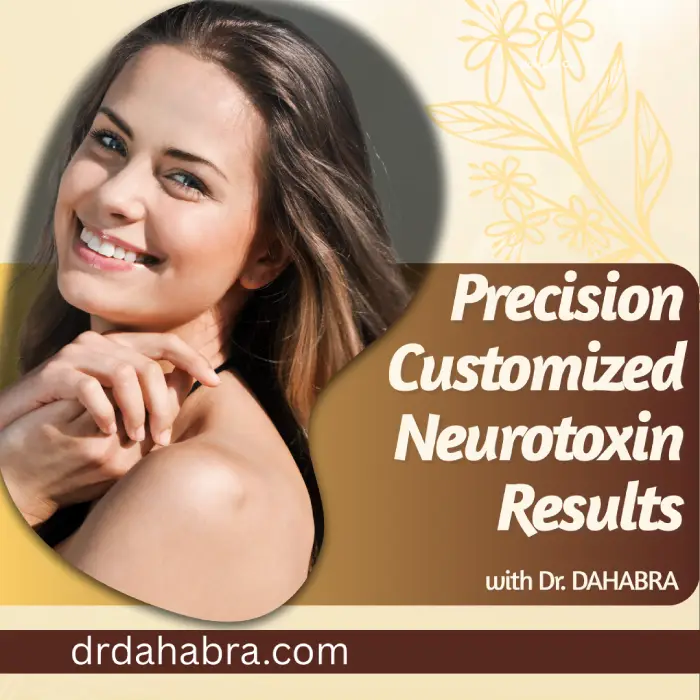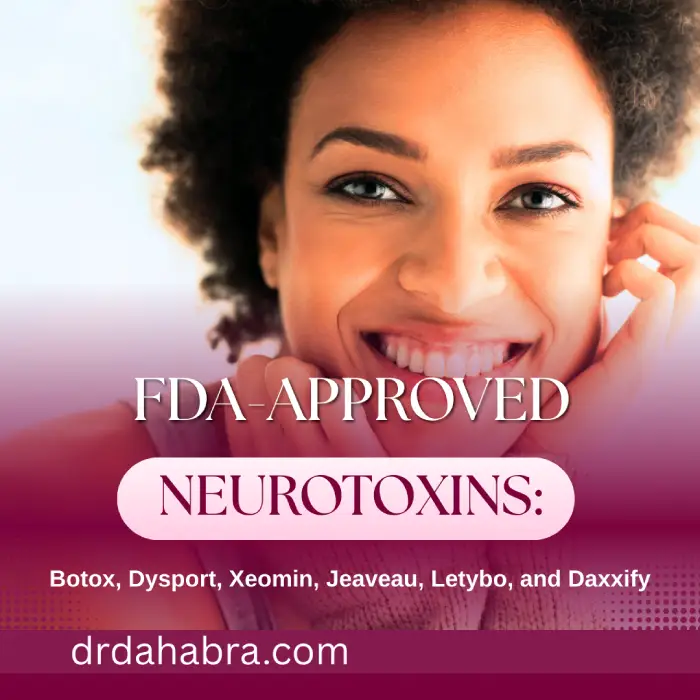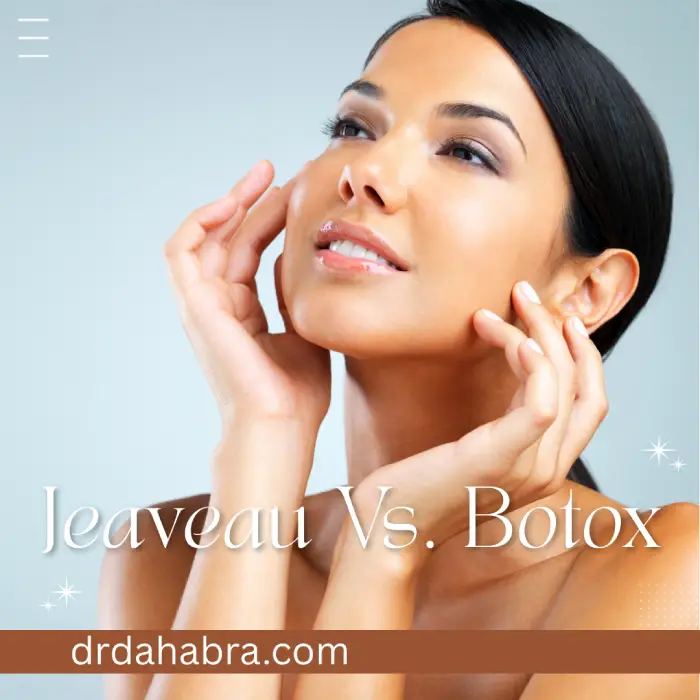The 5 Nonsurgical Anti-Aging Trends Aesthetic Experts Predict for 2026
What is driving the demand for nonsurgical anti‑aging treatments in 2026?
In 2026, the push toward nonsurgical anti-aging is being fueled by a convergence of consumer preferences, technological advances, and preventive mindsets. This article covers the 5 Nonsurgical Anti-Aging Trends Aesthetic Experts Predict for 2026.
Patients are increasingly seeking treatments that offer minimal downtime, natural-looking results, and preserve youthful skin without the need for surgery. The shift is away from dramatic transformations toward subtle rejuvenation, “tweakments” over estiramientos faciales.
Younger generations are embracing preventative anti-aging treatments earlier, viewing injectables, skin tightening, and advanced cuidado de la piel not just as corrective but also as a protective measure. This prejuvenation mindset expands the patient base and drives demand.
Advanced tools and AI skin diagnostics make these treatments safer, more personalized, and more efficient.
Regulatory clarity and improved safety profiles also contribute to this. As devices refine energy delivery and cooling, side effects decrease, thereby increasing patient confidence and trust.
Clinics are layering therapies, combining nonsurgical skin tightening, biostimulatory rellenos dérmicos, RF microneedling for wrinkles, and fractional laser skin resurfacing to produce full-face results that feel “untouched.” Experts now forecast that nonsurgical modalities may outpace surgical ones in growth by the late 2020s.
Índice
1. How are advanced injectables and fillers evolving toward subtle enhancement?
2. How does Baby Botox work as a preventative neuromodulator approach?
3. How are biostimulatory dermal fillers reshaping the injectables landscape?
4. Why is collagen‑stimulating therapy (RF microneedling, Venus Legacy, PRP) a central pillar for 2026?
5. What makes RF microneedling (e.g., Pixel8) a new gold standard for skin tightening?
6. How is Venus Legacy evolving to be more effective and comfortable?
7. What’s the role of PRP microneedling, and what drives its cost structure?
8. How are AI and holistic approaches personalizing anti‑aging strategies in 2026?
9. How is wellness‑integrated aesthetics redefining prevention and longevity?
10. Which laser and light‑based treatments are leading in 2026, and what are their benefits?
11. Can fractional laser resurfacing (e.g., Erbium) deliver true “glass skin” results?
12. Are at‑home anti‑aging devices (LED masks, microcurrent) credible clinical tools?
13. How are skincare trends shifting toward barrier repair and exosome serums?
14. Why is full-face aesthetic rejuvenation preferred over isolated “spot fixes”?
15. Preguntas más frecuentes (FAQ)
16. Conclusión
17. Reference
1. How are advanced injectables and fillers evolving toward subtle enhancement?
In 2026, one of the biggest trends is the pivot from bold, volumizing relleno looks to natural volume restoration and soft contouring.
The goal is not to look “filled” but gently lifted, as if youth has been preserved rather than forced. Patients want to age better, not look done.
Biostimulatory agents, fillers designed to stimulate the production of new collagen, such as poly-L-lactic acid or calcium hydroxyapatite-based products, are gaining notoriety.
They act more like scaffolds, prompting the skin to rebuild itself over months, rather than simply packing in volume in the moment. This shift transforms injectables into regenerative therapies, rather than purely augmenting.
Clinicians are also combining low-dose relleno with neuromodulators to optimize results. A tiny amount of filler can support the structure, while Baby Botox microdosing relaxes the expression lines, achieving subtlety rather than stiffness.
Younger patients are using small amounts of neuromodulators preventatively, before deep lines set in.
2. How does Baby Botox work as a preventative neuromodulator approach?
Baby Botox refers to microdoses of botulinum toxin, often administered in lower amounts than traditional dosing, strategically placed to soften movement without creating a “frozen” appearance.
The goal is to subtly modulate muscles, slow wrinkle formation, and preserve expressiveness.
Younger adults (late 20s to 40s) are using Botox in this way, not just to erase lines but to prevent them. By smoothing micro-contractions early, the skin endures less mechanical stress over time, thereby delaying the formation of deeper creases.
This preventative use has become part of the nonsurgical toolkit for 2026.
Because the doses are small, recovery is minimal. Some swelling or redness resolves within hours. When used judiciously, Baby Botox enhances rather than erases character.
Over time, regular maintenance sessions, every 3–4 months, help sustain the effect.
3. How are biostimulatory dermal fillers reshaping the injectables landscape?
A diferencia de la hyaluronic acid fillers, biostimulatory dermal fillers aim to stimulate the production of new collagen (and sometimes elastin) over several months, resulting in more natural and longer-lasting structural support. They serve as both volumizers and stimulators, bridging correction and regeneration.
Estos fillers support a trend called “nonsurgical skin tightening from within.” Because they gradually firm skin, they reduce reliance on repeated volume injections.
In practice, clinicians combine small volumes of biostimulators with HA fillers, a hybrid approach that blends immediate lift with long-term remodeling.
Longevity is a major draw: many biostimulators can last 18–24 months or more, depending on placement, patient biology, and follow-up care. As safety protocols improve, more patients feel comfortable using them at an earlier age.
The move is toward injectable filler alternatives that integrate structure and biology.
4. Why is collagen‑stimulating therapy (RF microneedling, Venus Legacy, PRP) a central pillar for 2026?
Collagen is the engine of youthful skin, and therapies that reliably induce collagen gain are now cornerstone modalities in 2026. Rather than “fill the hole,” physicians want to rebuild the terrain.
RF microneedling for wrinkles combines microneedling with radiofrequency energy to address wrinkles. The microchannels, combined with heat, stimulate fibroblasts deep within the dermis, improving laxity, texture, and fine lines.
Collagen induction therapy has long been a foundation; adding RF supercharges it. Studies support the concept of synergy when paired with regenerative agents, such as exosomes.
Venus Legacy (focused RF) continues to evolve, offering deeper lifting energy than RF while preserving the superficial layers. It is primarily used in the areas around the neck, jawline, and brow.
The comfort and targeting continue to improve, expanding its appeal.
PRP microneedling, drawing the patient’s own platelet-rich plasma and applying it via microneedling, remains popular as a biologic booster. Its regenerative capacity complements energy-based treatments, though coste and variable yield have limited uniform adoption.
Together, these modalities form a backbone of minimally invasive rejuvenation: stimulate, restore, strengthen.
5. What makes RF microneedling (e.g., Pixel8) a new gold standard for skin tightening?
Among RF microneedling platforms, the Pixel8 is emerging as a go-to option due to its fine-tuned energy control, multi-depth needles, and integration with topical boosters (e.g., growth factors or exosomes). The concept is nonsurgical skin tightening with minimal downtime.
Patients experience moderate redness and swelling for 24–48 hours, rather than days of peeling. The device’s precision allows customizing depth based on zones (cheeks, perioral, neck) and skin thickness.
Many practitioners report better tightening and smoother texture compared to microneedling alone.
Because it combines heat and physical disruption, Vivace Ultra is part of a trend toward integrating mechanical, thermal, and regenerative signals in a single session.
Clinicians often combine treatments, such as exfoliaciones químicas, exosome anti-aging serums, or light therapy, to maximize the effect in a single visit.
6. How is Venus Legacy evolving to be more effective and comfortable?
Venus Legacy has long been known for delivering radiofrequency energy deep beneath the skin to ascensor and tighten, especially around the jawline, brow, and neck. But in 2026, this technology has taken a giant leap forward.
Innovations now enable more precise depth targeting, adjustable energy pulses, and real-time imaging, allowing clinicians to see precisely where they’re working for more consistent results.
The biggest complaint with traditional VL was discomfort. Fortunately, new versions include cooling protocols, optimized handpieces, and staggered pulse delivery that reduce pain and make sessions far more tolerable.
As a result, more people are willing to consider it as a nonsurgical alternative to a neck lift or brow lift.
It’s also now common to pair Venus Legacy with biostimulatory dermal fillers or exosome anti-aging serums to enhance lift and stimulate collagen in the superficial layers, while Ultherapy targets deeper tissue.
The outcome is not just tighter skin, but more youthful, resilient skin that looks natural and feels firmer.
7. What’s the role of PRP microneedling, and what drives its cost structure?
PRP microneedling, often referred to as the “Vampire Facial,” remains a fan favorite in 2026 for its unique ability to harness your body’s natural healing powers.
It involves drawing a small amount of your blood, spinning it in a centrifuge to isolate platelet-rich plasma, and microneedling it back into your skin. These platelets are full of growth factors that promote collagen induction therapy and skin regeneration.
What makes PRP valuable is its versatility: it improves tone, smooths wrinkles, fades cicatrices de acné, and gives a healthy glow. It’s particularly beneficial when paired with RF microneedling or fractional lasers.
Think of it as fertilizer for freshly tilled skin.
However, the cost of PRP microneedling varies widely. It depends on the quality of the centrifuge system, the expertise of the provider, and whether it’s bundled with other therapies, such as exosome serums or chemical peel anti-aging treatments.
On average, expect to pay $600–$1,500 per session, primarily if it includes add-ons or advanced microneedling devices, such as Vivace Ultra.
8. How are AI and holistic approaches personalizing anti-aging strategies in 2026?
In 2026, anti-aging is no longer a one-size-fits-all approach.
Thanks to AI-driven diagnostics, treatments are now built around your individual skin profile, lifestyle, genetic tendencies, and even stress levels. Smart skin scanners assess hydration, pore size, collagen levels, and more, then generate tailored regimens that incorporate high-tech beauty tools, energy-based therapies, and skincare products.
Beyond tech, there’s a rise in wellness-integrated aesthetics, blending beauty with health. Clinics now consider hormone balance, sleep hygiene, gut health, and even mindfulness as part of the aging equation.
You might walk into a medspa and leave with a comprehensive plan that includes supplements, adaptogens, meditation apps, and hydration goals, alongside your nonsurgical skin tightening protocol.
Este holístico approach isn’t about replacing injectables or lasers; it’s about optimizing your baseline so those treatments perform better and last longer.
AI tells the practitioner exactly where to focus; wellness practices ensure your body has what it needs to support healing and collagen production.
9. How is wellness-integrated aesthetics redefining prevention and longevity?
Wellness and aesthetics used to live in separate worlds.
But in 2026, they’re increasingly intertwined. The latest thinking is: what good is piel resplandeciente if your gut is inflamed or your cortisol levels are through the roof?
Beauty is being redefined as a marker of overall vitality, not just what you do with needles or lasers.
Preventative anti-aging treatments now include IV nutrient therapy, peptide stacks, and biohacking tools like red light therapy and lymphatic massage. These help optimize cellular repair, boost mitochondrial health, and reduce systemic inflammation, all of which can be visible on your cara.
Even providers are shifting language from “correction” to “preservation.” With full-face planning and integrated longevity strategies, the goal is to make aging graceful, resilient, and empowering.
Patients leave their appointments with more than tighter skin; they leave with actionable habits that promote natural volume restoration and energy balance for the long term.
10. Which laser and light-based treatments are leading in 2026, and what are their benefits?
Laser and light-based devices are hotter than ever in 2026, but the technology has become significantly smarter.
Today’s systems don’t just blast the skin; they treat it with precision, respecting its barrier while promoting change from within. The latest trend?
Multi-functional platforms that can do several jobs at once.
Fractional laser skin resurfacing, like LaseMD Ultra, is a standout. It resurfaces the skin, improves tone, smooths fine lines, and reduces pigmentation, all while minimizing downtime.
Es often referred to as the “glass skin” laser for good reason. Pair it with exosome anti-aging serums post-procedure, and the results are amplified tenfold.
Meanwhile, Intense Pulsed Light (IPL) and LED therapy continue to evolve. IPL addresses redness, sun damage, and uneven tone with new filters and cooling features.
LED masks, particularly those emitting red and near-infrared light, stimulate collagen production and reduce inflammation. Some are even used at home with great results, if they’re medical-grade.
11. Can fractional laser resurfacing (e.g., Erbium) deliver true “glass skin” results?
Yes, and it’s one of the reasons Palomar Icon Erbium is making headlines in 2026.
This fractional laser skin resurfacing treatment targets the upper dermis, triggering collagen regeneration while refining skin texture and tone. It’s gentle enough for most skin types yet powerful enough to erase signs of sun damage and aging.
What sets it apart is its ability to create a luminous, even-toned finish that reflects light, hence the term “glass skin.” It also opens microchannels in the skin, allowing serums such as exosomes or growth factors to penetrate deeply and work more effectively.
Many patients report a visible transformation after just one session.
You’ll still need a series of treatments and proper skincare to maintain results. But for those seeking refinement without harsh peelings or extended downtime, LaseMD Ultra offers a sweet spot between power and gentleness.
It has become a go-to option for rejuvenecimiento facial completo, often paired with collagen induction therapy.
12. Are at-home anti-aging devices (LED masks, microcurrent) credible clinical tools?
Back in the day, at-home tools were more gimmicky than game-changing.
But in 2026, things have changed significantly. Today’s at-home anti-aging devices include high-tech beauty tools such as LED masks with clinically validated wavelengths, microcurrent devices that tone facial muscles, and dermarollers featuring skin-safe, fine-tipped needles.
Still, not all devices are created equal. Some brands are as powerful as what you’d find in a clinic (with FDA clearance), while others barely tickle the surface. It’s crucial to do your homework and stick with reputable manufacturers.
Even then, consistency is key. You won’t see results if your LED mask lives in a drawer. Think of these tools as supplements, not replacements.
They support the results from your in-office treatments, prolong the glow, and help with upkeep. But for real estimulación del colágeno or deep lifting, devices like Vivace Ultra or in-office RF microneedling still reign supreme.
13. How are skincare trends shifting toward barrier repair and exosome serums?
The skincare world in 2026 is shifting focus, from stripping and resurfacing to healing and rebuilding.
Instead of waging war on the skin with acids and actives, patients are now nurturing their skin’s microbiome and moisture barrier. Why?
Because a healthy barrier equals better treatment results and less inflammation.
Enter barrier-repair serums packed with ceramides, niacinamide, squalane, and panthenol. These ingredients rebuild the skin’s protective layer, reduce transepidermal water loss, and create a calm foundation for actives or post-procedure healing.
They’re especially crucial after lasers, microneedling, or peels.
On the high-end side, exosome anti-aging serums are making a significant impact. These are derived from stem cells and deliver molecular signals that enhance collagen production, reduce inflammation, and accelerate recovery.
They’re being used as both standalone anti-aging solutions and as post-treatment accelerators for collagen induction therapy. Skin that was once dull and inflamed now looks dewy and resilient.
14. Why is full-face aesthetic rejuvenation preferred over isolated “spot fixes”?
Once upon a time, patients would walk into clinics, pointing to a single line or fold, and say, “Fix this!” But in 2026, that approach feels outdated.
Why?
Aging occurs globally across the face, not in a single isolated spot. Treating one area while ignoring the rest often leads to imbalanced, unnatural results.
Por eso full-face aesthetic rejuvenation is the new gold standard. It looks at the entire facial structure, skin tone, volume loss, muscle activity, bone shifts, and elasticity, and addresses them in harmony.
Instead of only filling nasolabial folds, a clinician might lift the midface, soften dynamic lines with Baby Botox, tighten the jaw with RF microneedling, and improve texture with fractional laser skin resurfacing.
The outcome is more balanced, natural, and cohesive. Patients look rested, not “done.”
¿Y lo mejor?
This approach often requires fewer total treatments over time because each component supports the others, thereby reducing the overall treatment burden. It’s like giving your face a symphony instead of just one loud note.
15. Frequently Asked Questions (FAQs) about The 5 Nonsurgical Anti-Aging Trends Aesthetic Experts Predict for 2026
Q1. What is trending in 2025 for anti‑aging?
Respuesta concisa: Regenerative treatments (exosomes, biostimulators), AI-driven personalization, and energy-based skin tightening are expected to dominate 2025 trends.
Respuesta detallada: In 2025, the aesthetic space has shifted away from aggressive resurfacing and large-volume rellenos toward therapies that reboot the skin’s biology. Exosome anti-aging serums, stem cell–derived vesicles, and biostimulatory fillers are gaining traction as clinicians emphasize skin health over sheer volume.
AI skin-scanning tools and predictive algorithms tailor treatment plans. Energy-based devices, such as RF microneedling, ultrasound, and fractional lasers, are prioritized for minimal downtime and resultados naturales.
The “wellness‑integrated aesthetics” model also grew, blending lifestyle, nutrition, and aesthetics into cohesive plans.
Q2. What is the beauty industry trend in 2026?
Respuesta concisa: In 2026, personalization, layered therapies, preventative treatments, and high-tech devices will lead the beauty industry.
Respuesta detallada: The 2026 beauty trend is hyper-personalization: AI skin scans, genetic or biomarker data, and lifestyle inputs will guide bespoke regimens. Patients expect combinations of nonsurgical skin tightening, injectable filler alternatives, laser resurfacing, and skin health protocols.
Preventative approaches (prejuvenation) become standard. High-tech beauty tools, at-home anti-aging devices, and clinical-grade barrier repair move in parallel.
Clinics are increasingly merging wellness, nutrition, and stress support into their aesthetic protocols.
Q3. What is the most popular beauty treatment in 2025?
Respuesta concisa: Microneedling (especially RF microneedling with adjuncts) and neuromodulator injectables continue to top the charts in 2025.
Respuesta detallada: Among minimally invasive options, RF microneedling paired with growth factors or exosomes ranks high because it combines rejuvenation, tightening, and minimal downtime. Neuromodulators (Botox, Dysport) remain staples, particularly in microdoses (Baby Botox) used preventatively.
Hybrid protocols, layering injectables, energy devices, and skin boosters are also rising, capturing the interest of both existing and new aesthetic patients.
Q4. What is the best nonsurgical treatment for aging skin?
Respuesta concisa: There is no single “best” choice; the ideal nonsurgical treatment is often a customized protocol that combines collagen stimulators, fillers, and resurfacing.
Respuesta detallada: Skin aging is a multifactorial process, so the most effective approach integrates various modalities: RF microneedling for wrinkles, biostimulatory rellenos dérmicos for structural support, fractional laser skin resurfacing for texture improvement, and potent skincare (e.g., exosome serums, barrier repair) for additional support.
For skin laxity, Ultherapy or nonsurgical skin tightening devices complement injectables. The key is to tailor the intensity, depth, and sequencing to each patient’s aging stage, skin type, and goals.
Q5. Is “Collagen Banking” the smartest investment for your 30s?
Respuesta concisa: “Collagen banking”, using early regenerative treatments to preserve or boost collagen, can be wise, but must be balanced with safety and maintenance.
Respuesta detallada: The concept of collagen banking is that by building collagen reserves early (in your 30s), you may prevent deeper lines later. Clever use of low-to-moderate collagen-stimulating therapies (e.g., RF microneedling, light energy, gentle biostimulators) can support this.
However, overdoing treatments prematurely can backfire (excess stimulation, budget burnout). Choosing safe, mild protocols and spacing them appropriately allows you to “bank” improvements gradually, preserving natural aging rather than chasing unnatural youth.
Q6. How is AI and skin scanning technology personalizing treatment plans?
Respuesta concisa: AI and skin scanners analyze texture, pigmentation, elasticity, and moisture to create tailor-made regimens that combine devices and injectables.
Respuesta detallada: Tools such as high-resolution imaging, 3D mapping, and AI algorithms break down a face into actionable maps of collagen loss, sun damage, volume drift, and barrier integrity. Based on that biometric data, software models suggest optimal energy settings, injection vectors, layering order, and maintenance intervals.
Providers use these insights to optimize combination treatments and avoid over- or under-treating zones, resulting in more precise, efficient, and safer protocols with measurable tracking over time.
Q7. What is the most innovative way to layer surgical and nonsurgical procedures for optimal results?
Respuesta concisa: Use nonsurgical modalities pre- and post-surgery to prime tissue, maintain results, and extend longevity of surgical outcomes.
Respuesta detallada: The ideal layering strategy might start with mild preventative treatments ahead of surgery (to improve skin quality), then complement surgery with laser resurfacing, RF tightening, or fillers during recovery. Post-operatively, lower-intensity modalities support collagen remodeling and delay relapse.
Muchos clinics are now planning aesthetic treatment combinations months or years in advance, treating patients progressively rather than all at once. This synergy preserves the look, reduces invasive intervals, and offers smoother transitions between phases.
Q8. How are treatment combinations addressing the entire facial structure (eyes, jawline, neck)?
Respuesta concisa: Clinics increasingly adopt full-face protocols rather than treating isolated spots, integrating modulators, energy, and lasers across contiguous regions.
Respuesta detallada: Rather than merely smoothing patas de gallo or nasolabial folds, aesthetic plans now treat the temples, cheeks, jawline, neck, and periocular zone in one cohesive strategy. For example: subtle filler support in the midface, RF microneedling on the lower face, Ultherapy at the jaw/neck, and láser fraccional resurfacing on the perioral zone.
This avoids unnatural transitions (“mismatch effect”) and supports harmony across contours. The shift is from “spot fixes” to full-face aesthetic rejuvenation.
Q9. What are the key safety considerations for combining multiple aesthetic procedures?
Respuesta concisa: Key safety factors include sufficient downtime spacing, energy interference, vascular risk, cumulative inflammation, and patient skin type.
Respuesta detallada: When layering modalities, it is essential to avoid overstressing tissues. For example, avoid applying high-energy lasers over freshly injected filler; space sessions to allow the inflammation to settle. Be cautious around vascular zones, such as the tear trough.
Always account for skin phototype, as darker skin is more prone to hyperpigmentation. Utilize cooling, select patients properly, and employ conservative parameters.
Clinics should have emergency protocols. Combining modalities raises complexity; planning is as essential as the procedure itself.
Q10. What’s the best maintenance routine after a high-tech nonsurgical treatment?
Respuesta concisa: Apply medical-grade skincare (antioxidants, barrier repair, sunscreen), periodic touch-up treatments, healthy lifestyle, and follow-up assessments.
Respuesta detallada: Immediately after in‑office treatments, barrier support (ceramides, panthenol, peptides) is crucial. Over the long term, daily SPF 30+ (often reapplied), antioxidants (e.g., vitamin C), and nightly retinoids or peptides maintain gains.
Clinics may schedule light “booster” sessions (e.g., mild RF, LED, microcurrent) every 3–6 months. Lifestyle factors, sleep, hydration, nutrition, and stress reduction significantly influence outcomes.
Monitoring via imaging ensures timely adjustments.
Q11. How vital is medical-grade skincare compared to professional procedures?
Respuesta concisa: Medical-grade skincare is foundational and augments the durability and safety of in-office treatments; it’s not less important, but complementary.
Respuesta detallada: Procedures spark change; skincare nurtures it. High-potency barrier-repair serums, peptides, growth factors, and exosome serums maintain and amplify results.
Poor home regimens can blunt or even reverse in-office gains. Think of professional treatments as a “boost,” and medical-grade skincare as the ongoing “fuel” for those gains.
The two must work in harmony.
Q12. How can a monthly facial, such as a HydraFacial, be worth the cost for anti-aging?
Respuesta concisa: If the facial includes potent actives, slight microexfoliation, duty-grade boosters, and shows measurable improvement (in texture and glow), it may justify the coste. Otherwise, less frequent professional sessions may be more efficient.
Respuesta detallada: Monthly tratamientos faciales, such as HydraFacial, can help maintain hydration, a glow, and minor surface clarity. But for robust anti-aging in 2026, you want evidence of estimulación del colágeno, barrier repair, and molecular repair rather than just surface polish.
If a facial includes boosters (e.g., peptides, growth factors) or microdelivery of actives, its value increases. If results stagnate, redirect the budget toward more potent devices or modalities.
Q13. Is prescription Tretinoin/Retinol still the most effective thing you can do for anti‑aging?
Respuesta concisa: Yes, retinoids remain a gold standard for cell turnover, collagen induction, and pigmentation control; modern modalities build on rather than replace them.
Respuesta detallada: Tretinoin (or prescription retinoids) continues to be one of the most studied and effective anti-aging actives. It accelerates cell turnover, helps reduce fine lines and pigmentation, and enhances collagen over time.
Advanced modalities (lasers, microneedling, exosomes) amplify structural remodeling, but without a consistent retinoid backbone, gains may regress faster. The key is integrating tolerable retinoid regimens with professional treatments.
Q14. What are the actual long‑term side effects of regular Botox and fillers?
Respuesta concisa: When used appropriately, side effects are minimal. Rare risks include migration, atrophy, asymmetry, immune reactions, or overuse, which can result in unnatural-looking outcomes.
Respuesta detallada: Over decades, some potential risks emerge if dosing is excessive or poorly placed: tejido blando atrophy from chronic over-relaxation, filler migration or lumping, vascular complications (rare), and immunologic reactions (infrequent). More commonly, poor technique leads to unnatural outcomes.
The safest approach is to use modest dosing, take regular intervals of rest, and monitor progress over time. There is no robust evidence that “regular Botox,” per se, is harmful if properly administered.
Q15. How do I select the most suitable nonsurgical treatment for my age group (30s, 40s, 50s, and above)?
Respuesta concisa: In your 30s, favor preventative approaches (Baby Botox, mild collagen stimulation); in your 40s, integrate dermal support and energy therapy; in your 50s and beyond, layer resurfacing and biostimulatory options.
Respuesta detallada:
- 30s: Focus on preventative tratamientos antiedad, microdosing neuromodulators, low-level RF microneedling, barrier repair, and exosome serums.
- 40s: Begin combining biostimulatory rellenos dérmicos, moderate RF or ultrasound tightening, and fractional resurfacing to correct early volume loss and laxity.
- 50s+: Use more aggressive collagen-stimulating modalities (e.g., RF microneedling, Ultherapy), deeper resurfacing (fractional laser skin resurfacing), and structural fillers, always with conservative layering to preserve resultados naturales.
16. Conclusion: The 5 Nonsurgical Anti-Aging Trends Aesthetic Experts Predict for 2026
The nonsurgical anti‑aging frontier in 2026 is defined by subtlety, regeneration, and personalization.
Gone are the days of overfilled faces or harsh peels; today’s clients strive for enhancements that feel like themselves, only fresher. By combining nonsurgical skin tightening, biostimulatory dermal fillers, RF microneedling for wrinkles, fractional laser skin resurfacing, and exosome anti-aging serums, aesthetic providers can deliver results aligned with evolving patient expectations.
Long-term success hinges on integrating preventative anti-aging treatments, thoughtful sequencing, and a strong foundation in medical-grade skincare.
The shift toward AI‑personalized plans and wellness-linked aesthetics means that in 2026, beauty care will cease to be purely cosmetic; it will become part of a holistic living strategy.
We have covered everything about The 5 Nonsurgical Anti-Aging Trends Aesthetic Experts Predict for 2026.
Top 5 Nonsurgical Anti-Aging Trends in 2026
Discover the 5 Nonsurgical Anti-Aging Trends Aesthetic Experts Predict for 2026 with Dr. Dahabra. ¿A qué esperas para liberar tu belleza?
Llámenos ahora al (954) 595-2607 o reserve online. Su viaje comienza con sólo un clic o una llamada.
Abraza la belleza, abraza la innovación - Embrace You.
17. Referencias
Biostimulants in Aesthetic Medicine: A Systematic Review and Meta‑Analysis
by L. Smith et al. (Oxford University Press / Aesthetic Surgery Journal)
This review examines the mechanisms by which biostimulatory injectables function (beyond mere volume replacement), their safety and efficacy, and how they stimulate extracellular matrix (ECM) remodeling in aesthetic applications.
Radiofrequency Microneedling: Technology, Devices, and Clinical Applications
(National Institutes / PMC)
A comprehensive review of RF microneedling devices, safety profiles, mechanism of action, parameters, and clinical outcomes in skin rejuvenation.
Clinical applications of exosomes in cosmetic dermatology
(PMC, U.S. government / multiple institutions)
This narrative review encompasses exosome biology, their sources, applications in dermatology, their regenerative effects, and current challenges in translating them to practice.
Effectiveness of Extracellular Vesicle Application in Skin Aging
(PMC / various research labs)
Examines the role of extracellular vesicles (EVs), including exosomes, in skin rejuvenation, summarizing in vitro and early clinical evidence of anti‑aging effects.
Needle Radiofrequency Combined with Topical Exosome Therapy: A Case Series
(PMC)
A case series exploring the combined use of needle-based RF and topical exosomes for acne and skin quality, relevant because it bridges energy device + regenerative agent concepts.
by V. M. Amaral et al. (Springer / reconstructive aesthetic surgery research)
Investigates the use of CaHA (a biostimulatory filler) in techniques combining lifting vectors and collagen stimulation across facial planes.
Aplicación de modalidades no quirúrgicas para mejorar el envejecimiento facial
(PMC / Wiley)
A broad review of injectables, energy devices, microneedling, and combination approaches in facial aging, emphasizing minimally invasive strategies.
(Cureus / open access)
Explores new developments across both surgical and nonsurgical modalities, with comparisons, safety considerations, and emerging trends.
(Wiley / Journal of Cosmetic Dermatology)
A clinical trial comparing PRP and stem cell–derived exosomes when used in conjunction with RF devices, thereby testing which regenerative adjunct may better support nonsurgical rejuvenation.
Exosomes for Skin Treatment: Therapeutic and Cosmetic Applications
(ScienceDirect / Elsevier)
A detailed review of how exosomes from different cell types are used to drive regeneration, modulate inflammation, and enhance skin repair in cosmetic dermatology.
